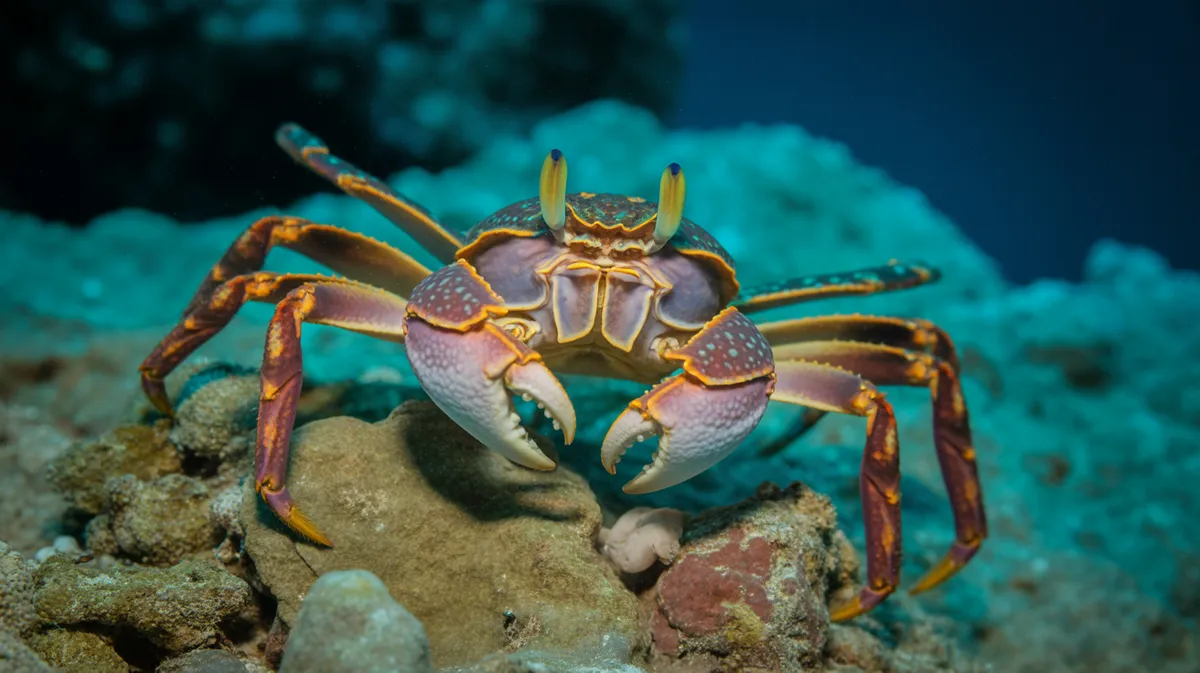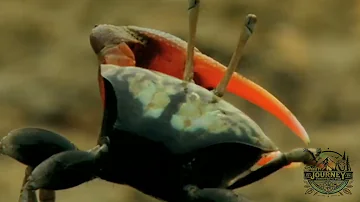
Pom-pom Crab
Lybia tessellata

Meet the Pom-pom Crab
The Pom-pom Crab, also known as the Boxer Crab, is a small and distinctive crustacean found in tropical Indo-Pacific coral reefs. It is renowned for carrying small sea anemones in its claws, which resemble tiny pom-poms and are used both for defense and for gathering food. The crab’s body is usually cream or beige with dark brown or black mosaic patterns, and it has long, slender legs. Despite its delicate appearance and small size, the Pom-pom Crab is a resourceful species that forms a mutualistic relationship with its anemone partners. Its secretive and nocturnal nature means it is more often observed at night, hiding among rocks and coral crevices.
Classification
Invertebrate
Habitat
Coral reefs
Diet
Omnivore
Lifespan
2-3 years
Conservation
Least Concern
Weight
1-3 grams
📖Fascinating Facts
Miniature Marvel
Pom-pom Crabs are tiny, typically measuring less than 2.5 cm (1 inch) across, making them one of the smallest crabs on coral reefs.
Mutualistic Relationship
The crab's partnership with sea anemones benefits both species: the crab gains protection and hunting tools, while the anemones get increased access to food.
Unique Defense
By waving their anemone-covered claws, Pom-pom Crabs can deter much larger predators with the threat of the anemones' stinging cells.
📋Detailed Description
Lybia tessellata, commonly known as the Pom-pom Crab or Boxer Crab, is a diminutive decapod crustacean, typically measuring 1–2.5 cm across the carapace. Its body is broad and flattened, adorned with a striking tessellated pattern of dark brown or black patches on a cream or yellowish background, providing effective camouflage among coral rubble. The most distinctive feature of this species is its symbiotic relationship with sea anemones (usually Bunodeopsis spp. or Triactis producta), which it holds in its chelae (claws) and waves defensively or uses to gather food. The crab’s chelipeds are elongated and delicate, while its walking legs are slender and banded, aiding in agile movement across complex reef structures. Lybia tessellata is primarily nocturnal, emerging at night to forage and remaining hidden in crevices during the day to avoid predators. Its eyes are set on short stalks, providing a wide field of vision crucial for detecting threats. The species is solitary and highly territorial, with individuals rarely tolerating conspecifics in close proximity except during mating. Its reproductive cycle is closely tied to lunar phases, and females carry fertilized eggs under their abdomen until hatching. The Pom-pom Crab’s mutualism with anemones is a unique evolutionary adaptation, offering both defense and enhanced feeding efficiency, and is a subject of ongoing scientific interest.
💡 Did you know?
Pom-pom Crabs can 'clone' their anemones by splitting them in half, ensuring they always have a pair of their signature pom-poms.
🔬Research & Sources
🎭Behavior & Social Structure
Pom-pom Crabs exhibit complex and specialized behaviors centered around their anemone partners. When threatened, they raise their claws and wave the anemones to deter predators, utilizing the stinging nematocysts of the anemones as a defense mechanism. For feeding, the crab uses the anemones to trap plankton and detritus, then carefully scrapes food from the anemone’s tentacles with its mouthparts. Lybia tessellata is an opportunistic omnivore, consuming small invertebrates, algae, and organic detritus. It is mainly nocturnal, emerging from hiding places after dusk to forage, and spends daylight hours concealed in coral rubble or crevices. Social interactions are generally limited to aggressive displays or avoidance, as individuals are territorial. If deprived of an anemone, the crab may split one into two pieces, encouraging regeneration and ensuring both claws are equipped. This behavior demonstrates advanced problem-solving and resource management.
👶Reproduction & Life Cycle
Reproduction in Lybia tessellata involves internal fertilization, with mating typically occurring during the warmer months and often synchronized with lunar cycles, which may enhance larval dispersal. Males approach receptive females cautiously, as females can be aggressive. After copulation, the female carries a clutch of fertilized eggs (often several hundred) attached to her pleopods beneath the abdomen. The incubation period lasts approximately 2–3 weeks, depending on water temperature. Upon hatching, planktonic larvae (zoeae) are released into the water column, where they undergo several molts before settling to the benthos and metamorphosing into juvenile crabs. There is no parental care beyond egg brooding; juveniles are independent from hatching.
🛡️Adaptations & Survival
The Pom-pom Crab’s most remarkable adaptation is its mutualistic relationship with sea anemones, which it uses for both defense and feeding. The crab’s chelae are specially adapted to hold and manipulate the delicate anemones without injury. Its cryptic coloration and flattened body aid in camouflage and allow it to squeeze into narrow crevices to avoid predators. The ability to split anemones and encourage regeneration ensures a constant supply of defensive tools. Nocturnality reduces predation risk and competition for food. The species’ small size and agility enable it to exploit microhabitats inaccessible to larger predators and competitors.
📚Research Sources
🎨Cultural Significance
While not prominent in traditional folklore, the Pom-pom Crab has gained popularity in marine aquarium culture due to its distinctive appearance and fascinating behavior. It is sometimes featured in educational and public aquarium displays to illustrate mutualistic relationships and reef biodiversity. The species has become a symbol of symbiosis and adaptation in popular science communication.
🔬Recent Research & Discoveries
Recent research has focused on the molecular and behavioral mechanisms underlying the crab-anemone mutualism, including how crabs recognize and select specific anemone species. Studies have documented the crab’s ability to induce asexual fission in anemones, a rare example of animal-induced clonal propagation in cnidarians. Ongoing research is investigating the ecological impact of this mutualism on reef community structure and the potential effects of environmental stressors on the partnership. Genetic studies are also clarifying the phylogenetic relationships within the genus Lybia and the co-evolution of crab and anemone partners.
🎥Wildlife Videos

Crabby Eaters | Animal Dance Battles
About National Geographic Wild: National Geographic Wild is a place for all things animals and for animal-lovers alike. Take a ...
Nat Geo Animals

Watch These Crabs Tear Their Living "Pom-Poms" to Shreds | National Geographic
Read more about how researchers studied pom-pom crabs and discovered this behavior, the first known case of one animal ...
National Geographic

This Crab has POM POMS! 🤯 🦀 Pom Pom Crab facts!
Meet the Pom Pom crab! A small crab that has sea anemones on its claws! Comment down below what sea creature you'd like to ...
All Things Marine Life

Boxer Crab Fights off Pufferfish
The boxer crab has an extraordinary method for self defense: it wards off predators using toxic sea anemones clenched in its tiny ...
Nature on PBS

Crab Chronicles: Exploring the World’s Most Amazing Crabs 🌊🦀
Discover: The Japanese Spider Crab with its record-breaking leg span 🕸️ The tiny yet fearless Pom-Pom Crab, nature's ...
Journey through the wild

All About The Pom Pom Crab
Have you been wanting a cheer leader in your saltwater aquarium? Boy, do I have the invert for you! Today's episode walks us ...
Brock Leonard
🌍Habitat Information
The Pom-pom Crab typically inhabits Coral reefs environments. Pom-pom Crabs have adapted to their environments with specialized features and behaviors.
Primary Habitat:
Coral reefs
More detailed habitat information will be available soon.
🛡️Conservation Status
The Pom-pom Crab is currently classified as Least Concern. Conservation efforts are crucial for preserving this species for future generations.
Common Threats:
- 🏠Habitat loss and fragmentation
- 🌡️Climate change impacts
- 🎯Hunting and poaching
- 🏭Human-wildlife conflict
⚠️Threats & Conservation Challenges
Currently assessed as Least Concern, Lybia tessellata faces localized threats from coral reef degradation, pollution, and habitat loss due to coastal development and climate change. Collection for the aquarium trade poses a minor but increasing risk, as its unique appearance makes it desirable among hobbyists. Ocean acidification and rising sea temperatures threaten both the crab and its anemone partners, potentially disrupting their mutualism. Population trends are stable in most areas, but ongoing habitat monitoring is recommended.
🔬Scientific Classification
Scientific Name
Lybia tessellata
Classification Hierarchy
🔍 About Taxonomic Classification
Taxonomic classification is a hierarchical system used by scientists to classify and organize living organisms based on shared characteristics and evolutionary relationships.
The system moves from broad categories (Kingdom) to increasingly specific ones, with each animal's scientific name typically consisting of its Genus and species.
📝Community Notes
Share your observations and insights about the Pom-pom Crab with our community of wildlife enthusiasts.
Join Our Community
Sign in to share your observations and connect with fellow wildlife enthusiasts.
Sign In to ContributeNo community notes yet
Be the first to share your observations about the Pom-pom Crab!
Explore Pom-pom Crab
Select a tab above to learn more about this amazing animal.
📸Photo Gallery
No photos available for this animal yet.
🌟Discover More Wildlife
Continue your journey of discovery with more fascinating animals from our database
